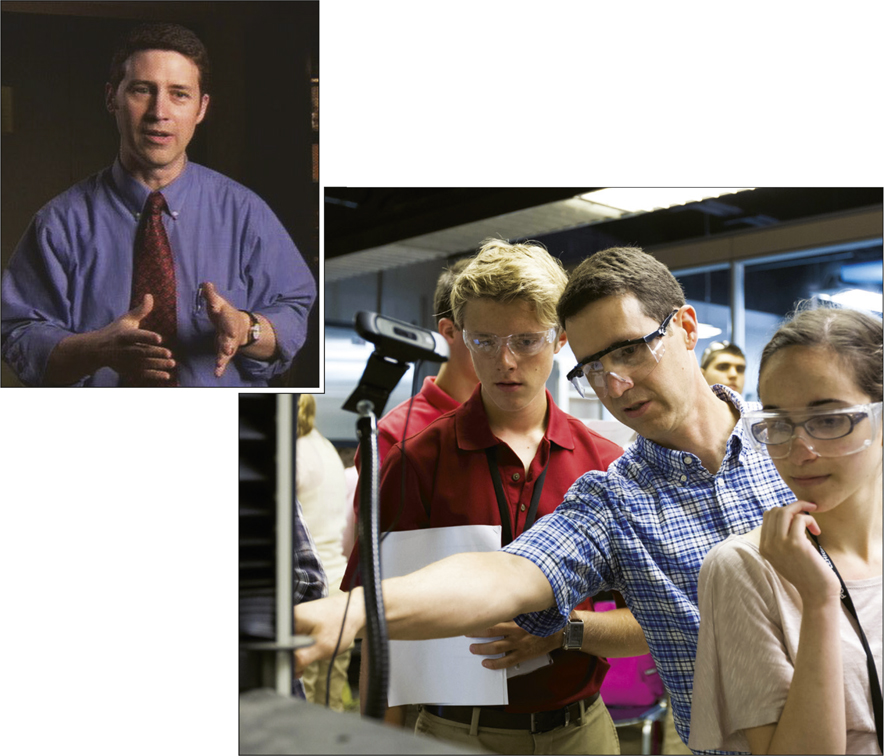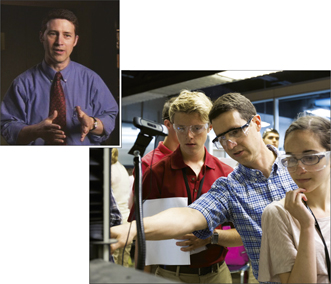
Richard “Rick” Paul Vinci, professor of materials science at Lehigh University, died in March from amyotrophic lateral sclerosis (ALS). He was 52 years old and will long be remembered as an outstanding husband, father, researcher, mentor, teacher, musician, and friend.
Rick grew up in Reading, Mass., and his interests and abilities in science led him to earn his BS degree in materials science and engineering (MSE) at the Massachusetts Institute of Technology (MIT). He then moved west to attend graduate school in MSE at Stanford University, where John Bravman advised him, in close association with Bill Nix. He began attending Materials Research Society (MRS) meetings on a regular basis during graduate school and remained a lifelong member thereafter. Rick’s dissertation research established what would become a career-long focus on the mechanical behavior of thin films and small volumes of materials.
After completing his PhD degree in MSE in 1996, Rick served two years as an acting assistant professor at Stanford, further developing his teaching and mentorship skills. He translated these to Lehigh University when he moved there in 1998. At Lehigh, he directed the Mechanical Behavior Laboratory for 18 years and then served as director of the pan-university Center for Advanced Materials and Nanotechnology (CAMN) for four years. His inherently collaborative nature made him well suited to running a center whose mission is to foster and support cross-disciplinary research and synergies.
Rick’s research modus operandi coupled a rigorous understanding of continuum mechanics and plasticity to explicit recognition of the importance of microstructure, supported by detailed structural characterization. He made significant use of in situ microscale testing pertinent to microelectromechanical systems (MEMS). The Vinci research group over the years made important advances, including the first measurements of stress relaxation in nanometer-scale aluminum films, the first conclusive demonstrations of linear viscoelasticity in face-centered-cubic metal films, the development of new models for MEMS performance degradation based on viscoelastic film behavior, the development and characterization of Au-V2O5 nanocomposite films for increased MEMS contact wear and creep resistance, the discovery of anomalous plasticity in Bi-doped Cu, and the demonstration of increased grain-boundary strength in rare-earth-doped magnesium aluminate spinel.
From all of the comments I have heard from Rick’s students, friends, and colleagues, it is clear that he was an unusually dedicated and gifted teacher. According to his Lehigh faculty colleague, Brian Slocum, “He was adored by his students. I remember, even before I actually knew Rick, hearing his students almost speak reverently about him. He was one of the few professors that put his duty and responsibility to teaching above all else.” Rick challenged his students and held them to high standards, but he was there for them as well. His empathy, caring, and obvious enthusiasm won over not just the minds of his students, but their hearts.
He was a devoted mentor to his graduate students. Trevor Verdonik, a recent graduate from Rick’s research group, said, “Rick exuded a joy of discovery that was infectious. You couldn’t help but to be inspired and excited about research when you spent time with him.” Rick won teaching awards at Lehigh from the departmental to the university level, as well as the ASM International Bradley Stoughton Award for Young Teachers. Lehigh’s P.C. Rossin College of Engineering and Applied Science has renamed its annual teaching award as the Richard P. Vinci Award for Educational Excellence.
In 2012, Rick’s colleague, Dick Hertzberg, invited him to help write the fifth edition of the highly regarded textbook, Deformation and Fracture Mechanics of Engineering Materials. Of Rick, Hertzberg said, “I consider him to be my academic son.”
Rick’s passion for promoting research and education in materials science inevitably took him outside of the laboratory and classroom. Throughout his career, he avidly led and participated in a range of informal science education programs. It was in this domain—public outreach—that I worked most closely with Rick. He made so many important contributions, both at the local and national levels. At Lehigh, he co-organ-ized popular ASM Materials Camps that introduced children to materials and materials science during a weeklong residential program. He brought demonstrations to local schools, libraries, and museums, as well as on campus. Rick had a strong affiliation with the science series NOVA, which was produced for the Public Broadcasting System by station WGBH in Boston. He featured prominently on screen in 2007 in the Secrets of the Samurai Sword and again in 2016 in the NOVA series Treasures of the Earth, where he appeared in the “Metals” and “Gems” episodes. The television loved Rick; his ability to render complex ideas to their simplest, most accessible foundations, his telegenic ease in front of the camera, and eyebrows that could speak volumes made him a natural on-camera expert.
The MRS Public Outreach Committee was established in 2005 and took on two major efforts over the next six years: the NOVA series Making Stuff and the Nanoscale Informal Science Education Network (NISENet). Rick was an integral part of both programs from their inception. Making Stuff was an ambitious project—a four-episode series on materials science and engineering with a strongly forward-looking focus. While Rick did not appear onscreen in Making Stuff, he was a core member of the technical advisory panel, and his ideas are particularly evident in the episode “Making Stuff Stronger.”

Top: Rick provides insight on NOVA’s Secrets of the Samurai Sword. Credit: WGBH Educational Foundation.
Right: Rick works closely with his students during class. Credit: Lehigh University.
NISENet was similarly ambitious, an NSF-funded, 10-year-long, USD$40 million project to create and launch important concepts and conversations on nanotechnology into an extended network of sites within communities large and small across the country. As of 2015, more than 30 million people have participated in NISENet programs. MRS was a key partner to the three science museums that acted as the principal drivers. The most visible outcome of this project were the NanoDays festivals and programs, which continue to this day. During the development of NISENet, Rick oversaw the Exhibits and Package Programs. He organized the NanoDays festivals and the Da Vinci Science Center in Allentown, Pa., using demonstration kits that he had a role in developing.
To both mashup and paraphrase several famous quotes: you can argue that a person is known by the friends they keep, and how they treat not only their colleagues, but also their subordinates. I’ve read and heard many tributes to Rick over the past months, and one aspect of Rick’s personality continually emerges—the exceptional kindness and humanity he embodied in every interaction, whether with a university president, a student, or a member of his CAMN staff. Jane Carlin, MSE Department Coordinator, recalled, “I never met a more selfless person than our Dr. Vinci. He shared his time and knowledge with any student who crossed his threshold. He was the professor with all the demo toys, [who] dressed as the Big Bad Wolf at Halloween, the one playing the trumpet with the band, competing in Bocce Ball at the department picnic with the students. He added so much to the materials family here at Lehigh.”
His colleague and former department chair, Helen Chan, said that Rick was, “academically brilliant, but a real people person who treated everyone around him with warmth and respect.” Rick and I most recently worked together for five years on a challenging outreach project, Strange Matter Green Earth. Beyond his great technical ideas and contributions to the project were the intangibles—a wry bit of humor that eased tense moments, a suggestion of such clarity that it broke a major logjam and a grace under pressure that made one wonder if he felt pressure at all.
Finally, you cannot know Rick if you don’t know how much he was dedicated to his wife, Michelle, and their daughters, Sofia and Julia. They gave him great joy and happiness. Rick was able to pen his own obituary, and I leave you with his words: “I, Richard P. Vinci, have lived a wonderful life filled with love, music, laughter, good health, and the pleasure of intellectual challenge.” We are all blessed to have known him.
Materials Research Society honors Rick Vinci
The Materials Research Society Board of Directors unanimously conferred a Board Special Recognition Award for Rick Vinci for the impact he made as a researcher, an educator, and a MRS volunteer, advancing materials research, mentoring the next generation, and engaging the broader public in science. MRS also approved and made a generous donation to the ALS Association to honor Rick.



